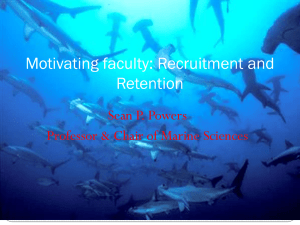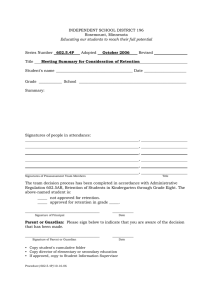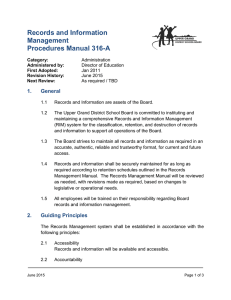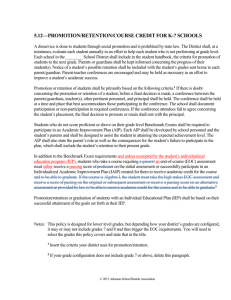2015 March Meeting Agenda/Minutes
advertisement
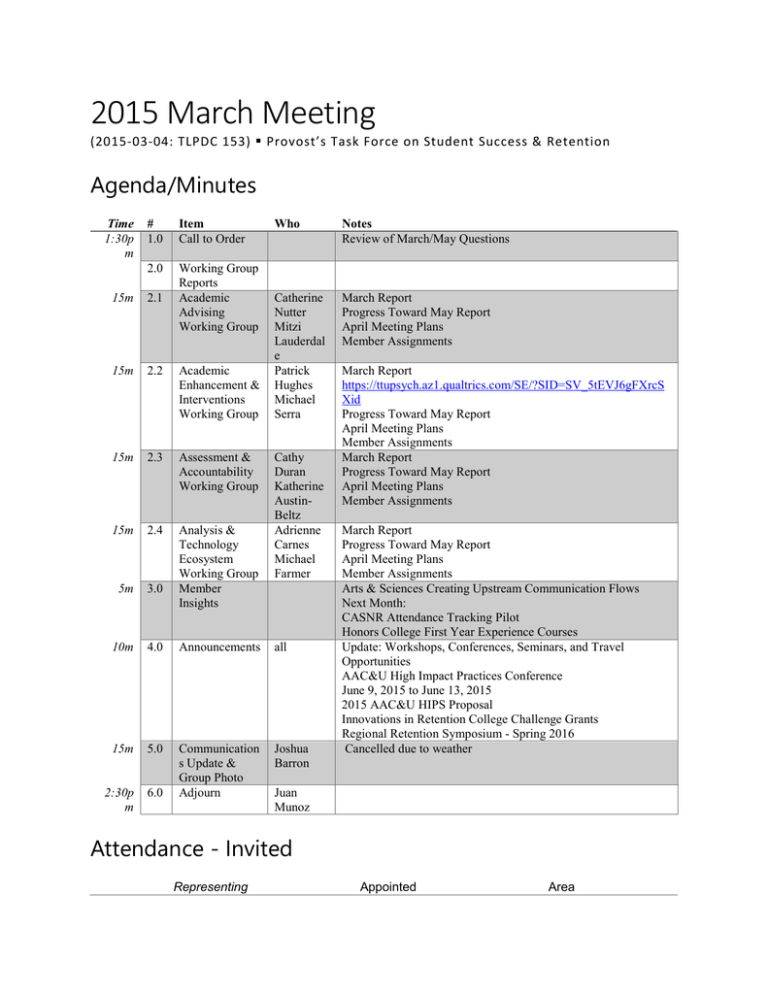
2015 March Meeting (2015-03-04: TLPDC 153) Provost’s Task Force on Student Success & Retention Agenda/Minutes Time 1:30p m # 1.0 Item Call to Order 2.0 Working Group Reports Academic Advising Working Group Who Notes Review of March/May Questions Catherine Nutter Mitzi Lauderdal e Patrick Hughes Michael Serra March Report Progress Toward May Report April Meeting Plans Member Assignments 15m 2.1 15m 2.2 Academic Enhancement & Interventions Working Group 15m 2.3 Assessment & Accountability Working Group 15m 2.4 5m 3.0 Analysis & Technology Ecosystem Working Group Member Insights 10m 4.0 Announcements all 15m 5.0 Joshua Barron 2:30p m 6.0 Communication s Update & Group Photo Adjourn Cathy Duran Katherine AustinBeltz Adrienne Carnes Michael Farmer March Report https://ttupsych.az1.qualtrics.com/SE/?SID=SV_5tEVJ6gFXrcS Xid Progress Toward May Report April Meeting Plans Member Assignments March Report Progress Toward May Report April Meeting Plans Member Assignments March Report Progress Toward May Report April Meeting Plans Member Assignments Arts & Sciences Creating Upstream Communication Flows Next Month: CASNR Attendance Tracking Pilot Honors College First Year Experience Courses Update: Workshops, Conferences, Seminars, and Travel Opportunities AAC&U High Impact Practices Conference June 9, 2015 to June 13, 2015 2015 AAC&U HIPS Proposal Innovations in Retention College Challenge Grants Regional Retention Symposium - Spring 2016 Cancelled due to weather Juan Munoz Attendance - Invited Representing Appointed Area Undergraduate Admissions International Affairs Worldwide eLearning Student Business Services Financial Aid Academic Associate Dean Ethan Logan Sukant Misra Justin Louder Christine Blakney Becky Wilson Cindy Akers Academic Associate Dean Academic Associate Dean Academic Associate Dean Academic Associate Dean University Advising College Advising Supervisor College Advising Supervisor Mitzi Lauderdale Keith Dye Stefanie Borst Kevin Stoker Catherine Nutter Adrienne Carnes Marijane Wernsman Susan Tomlinson Jeremy T Mason Lori Rodriguez Jamie L Perez Michael Farmer Fanni Coward Jennifer Snead Sam Jackson College Advising Supervisor Department/Program Advisor Department/Program Advisor Department/Program Advisor Faculty Senate Representative Full-time Faculty Full-time Faculty Full-time Faculty Full-time Faculty Full-time Faculty Full-time Faculty Full-time Faculty Full-time Faculty Institutional Research Associate Vice Provost for Undergraduate Education Associate Vice Provost for Student Affairs Office of Retention Analytics Vice Provost (convener) Michael Serra Kelli Cargile Cook Karen Alexander @Dimitri Pappas Laura Heinz Katherine AustinBeltz Patrick Hughes Administration Administration Administration Administration Administration College of Agricultural Sciences & Natural Resources College of Human Sciences College of Visual & Performing Arts College of Arts & Sciences College of Media & Communication University Programs Rawls College of Business College of Media & Communication Honors College College of Arts & Sciences College of Architecture Whitacre College of Engineering All Faculty College of Education College of Arts & Sciences College of Agricultural Sciences & Natural Resources College of Arts & Sciences College of Arts & Sciences College of Human Sciences College of Arts & Sciences University Libraries Administration Administration Cathy Duran Administration Joshua Barron Juan Muñoz Administration Administration 2015 March Report Academic Advising Working Group Provost’s Task Force on Student Success & Retention The Academic Advising subcommittee has identified two major working areas and smaller targets within these areas as places for focus, attention, and action. 1. Academic advising expectations and resources 1. Tools 2. Funding 3. Communication practices 4. Essential functions/responsibilities 2. Professionalization 1. Training 2. Professional development What does the literature say about each of our principal areas and their respective research questions? We have reviewed much of the literature concerning academic advising core values, essential skills, and professional development. In addition, we reviewed the Undergraduate Retention Initiatives white paper and the Noel Levitz report from 2010. Our findings and research questions are consistent with issues raised previously yet left unaddressed. What is the desired state or what should be our measures of success? The Academic Advising Subcommittee will be partnering with the other groups to create realistic and measurable assessments. Our end result is increased retention – of students and professional advisors. Using existing institutional data, what is our current state for each of these measures? We are creating surveys (in conjunction with the other groups) to determine the state of advising at Tech. We know that what exists in professional development and training is uncoordinated, uncommunicated, and often unsupported financially. We also know that the tools, funding, and communication practices are divergent and autonomous in many advising locations on campus. Essential functions have been normalized to a degree with the new levels in HR, but not everyone who advises fits into those categories, and not everyone who is called an academic advisor fulfills those listed functions. For May, we are planning an analysis of survey results to create recommendations for Fall implementation as suggested by impact, desired outcomes, and available resources. 2015 March Report Academic Enhancement & Interventions Provost’s Task Force on Student Success & Retention What does the (research, best practices, and thought leadership) literature say about each of our group’s principal areas and their respective research questions? What is the desired state OR what should be our group’s measures of success? Using existing institutional data, what is our current state for each of these measures? To answer this question, the working group has been preparing an inventory survey for identifying and gathering a more detailed understanding of the various retention initiatives across campus, particularly those that enhance the curricular experience in and beyond the classroom, along with those interventions that proactively intervene as initiated by various campus units (academic and support). The proposed survey/inventory is being considered in light of updates to the 2014 Undergraduate Retention Initiatives white paper and other information gathered in standard reporting, as well as measures collected for the recent SACSCOC reaccreditation process. A quick preview of the (work-in-process) inventory survey is available online at: https://ttupsych.az1.qualtrics.com/SE/?SID=SV_bmxddhaaliX1VYN Please include any comments/questions/suggestions below if you have them, or email them to michael.serra@ttu.edu directly, or come to the survey meeting when it's scheduled. 1 Accountability and Assessment Report Task Force for Retention and Student Success March 2015 Goals The subgroup developed the following goals for phase one: 1. Gather existing institutional metrics related to retention and student success a. Institutional Research b. Office of Planning and Assessment c. Enrollment Management d. Student Services e. Student Financial Aid 2. Survey colleges and units for existing retention and student success assessments a. All colleges, including Undergraduate Education b. Honors College c. Graduate School d. International Affairs 3. Identify assessment and accountability gaps in current assessment and accountability efforts a. Interview key campus support groups for input: i. Academic Advisor Group ii. eLearning Council iii. Academic Council iv. Associate Dean Council v. Faculty Senate b. Review existing literature and scholarly research to identify success predictors not currently implemented at Texas Tech University 4. Obtain direct student feedback to further identify predictors for success a. Meet with Student Government Association to solicit feedback 2 b. Identify key elements of the first year experience 5. Examine results of the EAB Student Collaborative Initiative a. Clearly identify the “mirky middle” for TTU b. Review list of gaps in accountability and assessment that are relevant to the “mirky middle” 6. Partner with other Task Force subgroups to develop assessment measures and identify accountability processes and procedures a. Review all proposed interventions and programming modifications b. Assist with the development of defensible assessment plans c. Establish accountability measures tied to strategic retention efforts d. Identify opportunities to leverage existing assessment tools and methodologies to incorporate new activities, interventions, and programs. Progress Report Goal 1: Gather existing institutional metrics related to retention and student success a. Institutional Research i. Benchmarking 3 ii. Further External Comparison iii. Predictive modeling tool for retention and enrollment planning 4 iv. Fact Book analysis by target group; example: 5 v. Provost College Dashboards vi. College Metrics Dashboard – Retention Over Time 6 vii. Student-Faculty Ratios viii. Online Data Trends http://www.irim.ttu.edu/Trends 7 b. Office of Planning and Assessment c. Enrollment Management Weekly Admission Reports, example: 8 d. Student Services In process e. Student Financial Aid Red Raider Guarantee Program Overview: The Red Raider Guarantee RRG Funded by (RRG) program was initiated Texas Tech University to correlate with the State’s Closing the Gaps initiatives. The RRG program was established in the fall of 2007, by Texas Tech University with the purpose, to ensure academically capable but financially disadvantaged students would have the opportunity to attend Texas Tech University and successfully complete a bachelor’s degree in a timely manner. The target, incoming freshmen whose household adjusted gross incomes were at or below $40,000 per year. RRG Funded by Federal & State Funds Amount Students Amount Students FY 2008 $ 578 $ 186,022 57 4,074,900 FY 2009 $ 573 $ 110,993 63 4,039,650 FY 2010 $ 1,072 $ 34,590 13 7,168,816 FY 2011 $ 964 $ 144,460 47 9,962,046 FY 2012 $ 911 $ 7,000 2 7,119,071 FY 2013 $7,346,279 814 $ 24,000 7 FY 2014 Tuition & Fee Revenue Collected by TTU Amount Students $4 635 ,508,500 $ 636 4,515,600 $ 1,085 8,463,000 $ 1,011 8,694,600 $ 913 8,308,300 $ 821 7,635,300 $ 848 7,886,400 $ 844 $ 13,150 4 7,876,370 Ethnicity (Percent of Students) and Average GPA and SAT Black Hispanic American Other Asian/ White Average Indian Pacific GPA Islander FY 2008 11.3% 28.1% 1.1% 0.2% 4.4% 55.0% 2.97 FY 2009 11.9% 26.7% 0.5% 0.8% 5.0% 55.0% 2.95 FY 2010 11.6% 34.0% 0.9% 2.4% 7.5% 43.6% 2.73 FY 2011 9.0% 14.8% 0.4% 10.1% 3.2% 62.5% 2.72 Average SAT 1072 1061 1077 1059 9 FY 2012 FY 2013 FY 2014 8.2% 10.9% 12.0% 14.9% 18.6% 18.3% 0.6% 0.5% 0.6% 9.0% 9.7% 7.1% 2.5% 5.5% 3.8% 64.8% 54.8% 58.2% 2.74 2.78 2.73 1063 1071 1087 Goal 2: Survey colleges and units for existing retention and student success assessments Assign task force members to conduct the following reviews – Meeting scheduled March 10: All colleges, including Undergraduate Education Honors College Graduate School International Affairs Goal 3: Identify assessment and accountability gaps in current assessment and accountability efforts – Develop an interview and feedback solicitation plan – Meeting scheduled March 10 Interview key campus support groups for input: i. Academic Advisor Group ii. eLearning Council iii. Academic Council iv. Associate Dean Council v. Faculty Senate Review existing literature and scholarly research to identify success predictors not currently implemented at Texas Tech University Literature review complete – posted on Wiki site for working group Goal 4 Obtain direct student feedback to further identify predictors for success – Develop plan during March 10 meeting Meet with Student Government Association to solicit feedback Identify key elements of the first year experience 10 Goal 5 Examine results of the EAB Student Collaborative Initiative Clearly identify the “mirky middle” for TTU Review list of gaps in accountability and assessment that are relevant to the “mirky middle” In process – working to evaluate historical data and present to subcommittee Goal 6 Partner with other Task Force subgroups to develop assessment measures and identify accountability processes and procedures – Planned for April work Review all proposed interventions and programming modifications Assist with the development of defensible assessment plans Establish accountability measures tied to strategic retention efforts Identify opportunities to leverage existing assessment tools and methodologies to incorporate new activities, interventions, and programs. 2015-02-25 Prep for March 4th Analysis & Technology Ecosystem Working Group Goals 1. Analysis - Inventory: To identify existing data analysis projects that may help better understand student retention patterns. 2. Analysis - Improve: To consider new data for analysis and action. 3. Technology - Inventory: To identify the elements in our technology ecosystem that support student success and retention, including computer systems in use by students, faculty, and support staff. 4. Technology - Improve: To consider new technology (and infrastructure) for integration, enhancement, and/or implementation. March Report What does the (research, best practices, and thought leadership) literature say about each of our principal areas and their respective research questions? Analysis Thought leadership suggests substantial value in a consistent institutional understanding of existing populations being analyzed by different campus groups. According to Bernadette Jungblut, Assessment Officer and Executive Director of Academic Success Initiatives for West Virginia University, and other Academic Impressions subject matter experts, the following is an example of analyses to be inventoried. Numerous reports, Noel-Levitz, agree with this approach. Population * Description * Size * Current 1-Year Retention Rate 1-Year Goal Retention Rate Identify population with low retention rate. Which population is at great risk of not persisting? What specific data points qualify a student as a member of this population? Quantity, in number of students, of this population. This helps to determine those populations that pose the most substantial threats to improving the institutional retention rate. % Based on the most recent data, what is the current first-tosecond year retention rate for this population? % What is the (immediate) target first-to-second year retention rate for this population? Analysis & Technology Ecosystem – March Report Current 4-Year Retention Rate 4-Year Goal Retention Rate Current 6-Year Graduation Rate 6-Year Goal Graduation Rate Info Needed Institutional Goal % Based on the most recent data, what is the current four-year retention rate for this population? % Based on the most recent data, what is the goal (immediate) four-year retention rate for this population? % Based on the most recent data, what is the current six-year graduation rate for this population? % Based on the most recent data, what is the goal (immediate) six-year graduation rate for this population? What more do you need to know about this population? What related institutional goal(s) will be met by directing resources toward this population? Technology Though there are many philosophies and frameworks available for guiding the process of improvement in technological tools and systems, the general outcomes of these approaches is essentially the same: facilitating due diligence, understanding a current state, and navigating the gap to arrive at some state closer to a stated ideal outcome. One of these approaches, created by Carnegie Mellon University's Software Engineering Institute, is equally helpful for examining improvement processes in software creation, business processes, and human factors. The CMU-SEI approach is known as the IDEAL model, and is depicted below. Page 2 of 3 Analysis & Technology Ecosystem – March Report What is the desired state OR what should be our measures of success? Analysis Once we have a consistent understanding of what institutionally is happening we can leverage technology to streamline, automate and validate formerly disparate processes. To understand the value of these improvements, we will measure this success by surveying campus users to complete the inventory and gauge their satisfaction now, and at various points in the future. Technology Once we have a consistent understanding of what is happening across the university we can select institutional solutions and configure these to meet the needs of each constituent group and their improved business processes. To understand the value of these improvements, we will measure this success by surveying campus users to complete the inventory and gauge their satisfaction now, and at various points in the future. Using existing institutional data, what is our current state for each of these measures? Analysis Thanks to the COGNOS review committee the usage of existing reports is known. Application development can also provide a summary of patterns, trends and themes in the requests they receive enhancing existing reports and creating new ones. However, no known survey has been conducted to inform us on the utility and usage of various reports and analyses for retention focused initiatives. Technology Thanks to an inventory provided by Information Technology the existence of current centralized technological systems is known. However, a wide variety of course-, program-, department-, and college- specific technologies are also in use ranging from pencil and paper to smartphone enabled apps and online web based systems. Page 3 of 3 AAC&U HIPS Proposal Application to the 2015 AAC&U High Impact Practices Institute – Texas Tech Introduction Texas Tech University is committed to excellence in research and student success. Few measures currently represent student academic success more clearly than the indices of retention, persistence, and graduation. The university’s first strategic priority, “Increase Enrollment and Promote Student Success,” as published in the institution’s 2020 Strategic Plan—Making It Possible, includes these metrics, placing the highest importance on improved student retention and graduation rates. We wonder, could there also be metrics that, to all of our students, are more meaningful, accessible, and actionable? Contribution Texas Tech’s units have already contributed in many ways to raise students’ expectations for learning. Recent efforts have added new practices, even while enhancing and scaling-up existing initiatives, e.g., redesigned Freshman Seminar, undecided student designation, risk analysis and targeted interventions via the Education Advisory Board Student Success Collaborative research services and technology platform, Red Raider Orientation, college-aligned tutoring, undergraduate research, and service learning. These all involve the principles, policies, and processes central in one or more of Kuh’s identified high-impact practices. Yet, at Texas Tech University, these excellent practices operate without substantial regard for one another. The ability to coordinate specialized and focused retention programs within distinct colleges is made difficult, not from a lack of willingness to collaborate, but due to the uniqueness of academic fields, varying levels of student preparedness, and available resources. To counter this reality, in fall 2014 the Provost established the Texas Tech Task Force on Student Success & Retention (TF:SSR). Its membership is comprised of 34 representatives including faculty, staff, and administrators. Each member is committed to serve in two of four smaller working groups. This cross-pollinated structure allows the task force to simultaneously engage complex retention issues that frequently span one or more of the working groups’ areas of focus: Assessment & Accountability, Analysis & Technology Ecosystem, Academic Advising, and Academic Enhancement & Intervention. Now a permanent addition to the university’s success and retention assets, this group is charged to be both guide and driver for the next stage of coordinated investments in campus-wide student success. Only a few months into its work, the task force has already begun making significant headway toward creating a first set of well-vetted recommendations. The model used to arrive at these recommendations includes surveying the literature on each focus area, developing research questions and hypotheses, constructing valid and reliable methodologies for gathering quantitative and qualitative inputs, and discussing limitations, implications for practitioners, and recommendations for future work. Need As commonly happens in the early stages of research, the team found a variety of positions on supporting success, along with differing scholarly and popular opinions on areas most in need of retention-related investment. These findings led to a general agreement that our first recommendations should be broad enough to target institutional frameworks that affect all students and their respective academic units, while simple enough to gain critical buy-in from a variety of constituents, including students. Outputs must positively influence pedagogies, enhance the opportunity for deeper learning experiences in each course, and directly connect with improved course completion, persistence, and degree attainment. Goals As its focus during the intensive cloister of the 2015 AAC&U HIPS Institute, our team has identified one underappreciated item meeting all criteria listed above: the mid-term grade. We propose to Decision Timeline Applicants will be notified of their status by April 7, 2015. About the Institute The Institute on High-Impact Practices and Student Success is designed to help campuses and systems make institution-wide changes that benefit all students. It is ideal for institutions at various stages of work, and it addresses ambitious goals for improving both completion rates and the quality of student learning. Participant teams work on removing barriers to student success and devising integrative learning-centered plans—making intentional and evidence-based use of Essential Learning Outcomes and high-impact practices. Highlighting the success of students who have historically been underserved, the program supports work to make excellence inclusive and to recognize and nurture the assets students bring to college. It provides insight into building and scaling up student success initiatives at the institutional level. The Institute draws on research documenting how all students can benefit from high-impact practices and highlights the value of such practices for students who have not been given access to high-impact learning. The Institute curriculum aims to help campuses define approaches that are highly engaging to students and effective at improving the equitable achievement of outcomes. Who Should Attend Teams typically consists of a team leader and four team members. Team leaders are most often senior academic or student affairs officers. Teams should be diverse and cross-functional, including faculty from a variety of disciplines. Teams should recruit individuals from various sectors of campus that will be significantly involved in the projected campus work, as well as key individuals who could extend the reach of action. In the past, teams have included faculty, provosts, deans, department chairs, student affairs educators, registrars, librarians, and students. invest time analyzing its current use and impact. Further, we will develop data-driven recommendations for improving institutional policy, faculty participation, college accountability, advisor communications, student awareness, and student responsiveness. Improvements to the use of mid-term grades will require a better understanding of how representative and meaningful these grades are in helping each student to monitor her/his own performance. This will be enhanced by a correlative data analysis to determine relationships between mid-term grades, final grades, credit accumulation, retention, and graduation rates. Including demographic and participation data in the statistical analysis should also confirm or deny gaps in the institution’s effectiveness with its diverse students. If found, these gaps would necessarily prompt further investigation, which might include a study of students’ current awareness of mid-term grades and what they indicate, and students’ perceived agency to utilize resources known to improve final course outcomes. Building on a new awareness of mid-term grades’ statistical realities, the team will spend the balance of its time constructing a plan of implementation for selected improvements. For example, the implementation plan may necessitate the creation of robust communication campaigns and the allocation of additional faculty supports. Initially engaging the executive sponsorship of administrators, communications and support efforts would, respectively, seek buy-in from the entire body of instructional faculty, and provide instructors assistance completing any modifications to their syllabi, course delivery, and assessment plans. If improvements include modifying existing policy, this would necessarily require a thorough consideration of historical, political, and organizational culture forces that might undermine the impact of the team’s proposed action plan. Finally, we anticipate the need for a communication and training plan for support staff, academic advisors and, most importantly, the creation of well-marketed tools and strategies that will involve, equip, and empower our students. Substantial impact will be achieved when students are prepared and motivated to leverage these newly improved mid-term metrics. Improving student, program, and institutional outcomes is most likely to occur when students can act in their own best interests during a period of the term when they still have substantial time to make important positive changes. By making the mid-term grade more meaningful, accessible, and actionable, we propose that Texas Tech’s institutional goals and student learning outcomes will be substantially enhanced, and its graduation goals significantly improved. Unfortunately, at this stage in the process, quantitative long-term outcomes are difficult to determine. Through the insights acquired from the HIPS institute, we expect to arrive at clear one- and three-year student success outcomes that demonstrate improvement in the value and use of mid-term grades as they become more supportive of student persistence. These might take the form of the following: Within one year, the team would hope to have a strong campus buy-in through curricular modifications and participation in units’ related student messaging, including faculty participation in at least 50% of all core courses, 75% of all service learning courses, and 100% of all courses involved in TTU learning communities. Within three years, the team hopes to see a number of positive statistical outcomes, including the following : an increased correlation between midterm grades and later-term use of support resources for students receiving low midterm grades a reduced correlation between midterm grades and final course grades for students receiving low midterm grades (due to these students' use of support resources) an increased correlation between midterm grades and final course grades for students receiving high midterm grades (due to our enhancement of the overall predictive accuracy of midterm-grades) faculty participation in submitting early and meaningful mid-term grades at a level surpassing 80% of all undergraduate courses at the institution, including 100% participation in all core, service learning, and capstone courses. Team Our proposed HIPS Institute team includes one volunteer member representing each of the four TF:SSR working groups. The representatives also come from different academic backgrounds, and their professional work responsibilities collectively cross the divides between faculty members, support staff, and institutional administrators. These four will be led by Joshua Barron, one of the campus administrators who serves as project manager for TF:SSR. Utilizing the existing framework and membership of TF:SSR will establish this project and provide greater campus visibility. Further, the experience will provide valuable professional development for TF:SSR members, enhancing other high-impact efforts of the group. This approach increases Event Logistics and Proposal Requirements http://www.aacu.org/summerinstit utes/hips/2015 Application Details The online application consists of an information section and a narrative section due no later than March 4, 2015. The narrative should not exceed 1,300 words. Consult the following prompts to guide the narrative. Questions are meant to suggest direction rather than to be exclusive. Need: What work has your institution planned or begun to build capacity for inclusion, engagement, and success for all students? How successful have you been at building interest and commitment? How successful have you been in transforming the curriculum to meet the changing demands for learning in the twenty-first century and the evolving demographics of the student body? What have you already accomplished related to learning outcomes, assessment, and student success? Who was involved? What are your next steps? Goals: What specific project or assignment do you expect to advance at the Institute? How does your project advance an inclusive approach to connect individuals from a range of campus sectors to larger institutional or systemic efforts for high-quality learning and student success? In what ways are your quality improvement and diversity efforts linked? What do you hope to achieve in the next year and in the next three years? Contributions: How has your campus contributed to local, regional, or national efforts to raise expectations for learning for all students? Team: What is the rationale for your team’s composition? How do team members reflect a shared commitment to inclusion, engagement, and excellence on your campus? the likelihood of successful implementation by making use of TFSSR members’ professional responsibilities and supervisory structures. Moreover, positive adoption is promoted by leveraging the TF:SSR members’ interpersonal influence as each engages her/his extensive campus network. Additional Questions Additional questions on the application were answered as follows: To help us better meet your needs, please tell us what specific topics you would like the institute program to address within each of the four general institute tracks. Goals Summary Please summarize your goals for the institute into 150 words or less in the following field: Demonstrated improvement in the value and use of mid-term grades as they become more supportive of student persistence, potentially measured as follows: Within one year, campus buy-in through curricular modifications and participation in units’ related student messaging, including mid-term grade submission surpassing 50% for core, 75% for service learning, and 100% for learning community courses. Within three years: increased correlation between midterm grades and later-term resources use for students receiving low mid-term grades reduced correlation between mid-term and final grades for students receiving low mid-terms (due to use of resources) increased correlation between mid-terms and final grades for students receiving high mid-terms (due to enhancement of overall predictive accuracy of mid-terms) faculty participation in submitting early and meaningful mid-term grades at a level surpassing 80% for all undergraduate courses, including 100% participation in all core, service learning, and capstone courses. High-Impact Learning: Pedagogies and Practices * High-Impact Learning: Pedagogies and Practices helps educators create high-quality learning experiences for all students. It addresses theories of learning and illustrates how to translate theory into practice. The track is designed to help participants use effective strategies and pedagogies as the means to advance equity and make excellence inclusive. Recognizing that this project will likely require curricular modifications to make mid -term grades more meaningful, actionable, and timely, the pedagogies and practices curriculum would be most helpful if it were to address theories of beneficial assessments, research on the timeliness, timing, and loading of course curricula, and practices for guiding and directing faculty members to implement th ese theories practically in their courses. Useful Evidence * Useful Evidence focuses on how campuses can utilize both indirect and direct assessments of high-impact practices to promote equity in student achievement of learning outcomes, and in the design and implementation of HIPs. Useful Evidence: Though mid-term grading focuses entirely on the alphabetic al grade assignment, the useful evidence curriculum would be most helpful if it were to provide deep insight,including a variety of examples, for constructing excellent assessable measures of student learning in coursework that is using high-impact practices to increase engagement and learning. Further, if the institute track were to examine the pros and cons of using one or more measures in each of these environments, this would be highly instructive as our team considers returning to campus and supporting faculty in making the assessments within their high-impact courses more beneficial for student action. Scaling High-Impact Practices * Scaling High-Impact Practices from entry to completion requires an intentional campus-wide, equity-minded framework. This track explores ways to incorporate AAC&U’s emerging work on guided learning pathways and problem-based pedagogies. The track focuses on the interrelationship among courses, programs, and resources needed to insure that each student has the opportunity to pursue and achieve a high-quality liberal education. This track is relevant to our team as it will be most useful in assisting to develop a comprehensive plan that encompasses curricular improvements, along with the cr eation of integrated support systems, conducive institutional policies, and engaging student response plans. Politics of Change * Politics of Change examines the nature of change at an institutional level and introduces meaningful change strategies. It explores intentional approaches to leadership development for senior-level administrators, faculty, and student affairs educators, recognizing political realities that shape the change process on campuses. Recognizing that no plan for change can happen in a vacuum, the politics of change curriculum would be most helpful if it provided communication recommendations and examples of similar improvement initiatives so the team might have an opportunity to benefit from the hard lessons learned by other teams approaching this type of widespread change.


